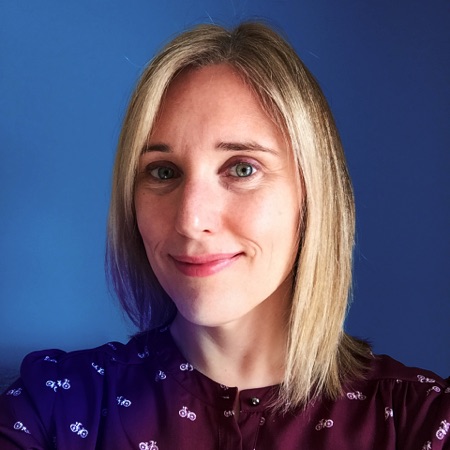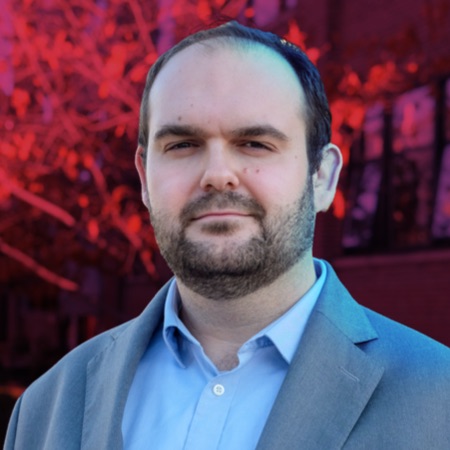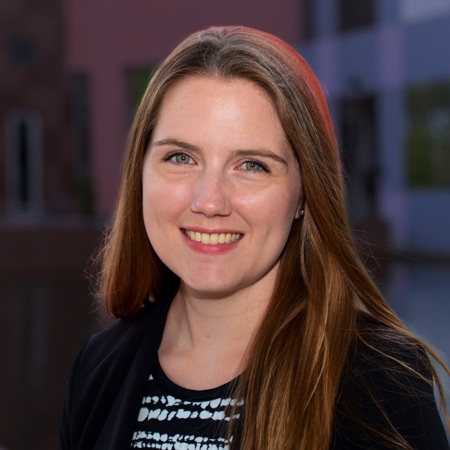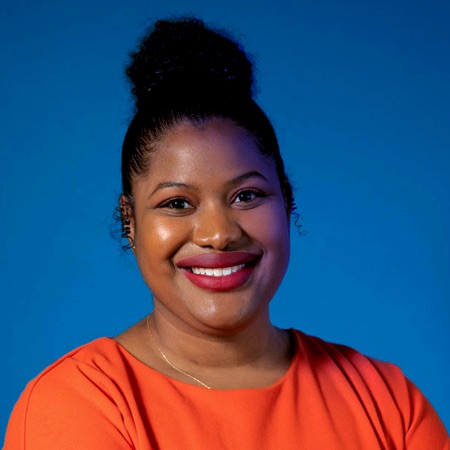10 experts for 10 years of analytics and AI
A decade ago, corporate Canada was calling for more managers with analytics expertise. In response, Smith created the Master of Management Analytics program. Five years later, as firms began harnessing the power of AI, the Master of Management in Artificial Intelligence launched. More than 1,600 students have graduated from these programs since. Today, they’re finding opportunities in the numbers and discovering the potential of machine learning for companies everywhere. To mark 10 years of the MMA (and five of the MMAI), we’re featuring 10 extraordinary analytics and AI professionals below.

Heidi Klotz
GMMA’21SNC-Lavalin
If you were to peruse the computer storage of any HR department, you would find a veritable Empire State Building-sized pile of documents. There are resumés, performance reviews, onboarding sheets, employee surveys and more. But for years, little was done with all this info. It just sat around.
Heidi Klotz is among the HR professionals changing that. Klotz is especially interested in applying natural language processing (NLP) to help employers retain talent.
One example is the annual performance review. Once managers and employees sign off, they usually get shelved and forgotten. But NLP analysis of performance reviews (across a company or in subsets) can help employers better understand key metrics like engagement or behaviour that contributes to either poor or exceptional performance. They can also gauge the risk of employees leaving, Klotz says. “There are just so many possible applications and so much opportunity in the HR space.”
Klotz started her career in the HR department at pharma giant Merck. She was good at Excel, which came in handy. At Merck, she learned how data and insights can help corporate leaders make smart decisions. Eventually, she realized the potential for analytics and AI in human resources. Today, as vice-president, total rewards–Americas, at SNC-Lavalin in Montreal, she’s responsible for all compensation and benefits programs across the company’s Canadian, American and Latin American operations, which includes around 15,000 employees.
Data and analytics shouldn’t be viewed as a catch-all solution to every HR problem, she says. But it can confirm or debunk long-held assumptions. A good example is the belief that to attract talent, companies must offer higher salaries to new employees. Analysis shows that’s not the case. “The data disproves this assumption,” Klotz says, “but managers still believe this is true.”

Joy Deslauriers
MMAI’20Amazon
Joy Deslauriers once thought she would either get her MBA or Master of Computer Science degree. But she really wanted a program with both management and technical expertise. That led her to Smith’s MMAI program. Today, she’s the senior business intelligence engineer and analytics lead at Amazon Ads. She also teaches a machine learning course at Smith.
Q. What got you interested in AI?
A. In 2018, I was a data engineer at TD when it acquired Layer 6, a Toronto-based AI startup. I was tasked with supporting the machine-learning models in production to facilitate real-world decision-making. I was intrigued by the discussions of the data scientists and became increasingly interested in the business applications of AI.
How do analytics and AI play into what you do at Amazon?
Amazon Ads offers many AI-powered online advertising solutions for businesses of all sizes. My team leverages machine-learning models to improve relationships between sellers on Amazon and advertising agencies. One analogy I’ve heard is that we’re connecting Mad Men-level expertise to businesses and creating a mutually beneficial customer experience for both parties.
What’s the most important thing you’ve learned about using data?
I’ve observed how preconceived notions can shape the way data is interpreted. It’s easy to let our biases influence decisions. So we need to challenge assumptions and bring in a variety of perspectives. Also, while averages can help us understand trends, they can obscure important details and variations that are critical to making informed decisions. Paying attention to anecdotal stories can provide valuable insights that may not be evident from averages alone.
What’s your advice for others starting in this field?
Augment your analytics or AI expertise with applied knowledge in a field you are passionate about. You can specialize through on-the-job experiences or higher education, but find an interest that sets you apart. True career fulfilment comes from applying analytics or AI knowledge to something you care deeply about. For me, that has been pursuing projects in financial literacy, small business success and teaching.

Adam Nathwani
AMBA’18, MMAI’21Drive Hockey Analytics
By now, we’ve all heard that analytics has forever changed the way pro sports teams are built. In the 2011 film Moneyball, analytics showed how players with high on-base percentages can help a baseball club win more games than a reliance on some traditional stats, like hits. In the NHL, puck possession has become the name of the game. Teams now crunch the numbers in search of players who can keep the puck.
But analytics is not just for the pros. Amateur teams, players and coaches are finding that a deep dive into data can improve their game, too. Adam Nathwani is at the forefront of the trend, as the chief operating officer at Drive Hockey Analytics. The Vancouver hockey tech startup offers AI and sensor-based player and puck-tracking technology to college, junior and youth organizations.
“Amateur teams are looking for the same information as the NHL to be more competitive and support player development,” he says. Drive Hockey’s systems help them do that.
Nathwani’s job combines two things he’s passionate about: hockey and AI. Before he enrolled in Smith’s MMAI program, he worked in management consulting in the tech sector. He soon realized how important AI was going to become for businesses. Before that, he played university and competitive youth hockey. He has also coached and scouted at the junior levels and done work for the NHL.
What’s the most important thing Nathwani has learned about using technology and data? That they are only tools. “They are not the solutions in and of themselves,” he says “Critical thinking and sound judgment are still required to make the best use of data and to apply it correctly to meet business objectives.”

Divya Tulapurkar
MBA’17 MMA’17EY
Growing up in Bangalore, India, Divya Tulapurkar loved math and science. “The ability to use data to infer patterns and determine a logical conclusion was just how my brain worked,” she says.
In India, Tulapurkar studied engineering. But she really wanted a career in which she could apply technology to drive results. So she moved to Canada to earn her MBA. But Tulapurkar wanted more technical knowledge, too. So she completed a Master of Management Analytics degree at the same time, shuttling between Goodes Hall (for the MBA) and SmithToronto (MMA).
Doing two graduate degrees at once in cities 250 kilometres apart is no easy feat for anyone, let alone a newcomer experiencing Canadian winter for the first time. But it was worth it, she says. “I don’t think I would be where I am in my career today if I hadn’t made that decision. The analytics degree positioned me as an analytics translator who could enable organizational changes through the power of data and insights.”
Today, Tulapurkar is a national leader at EY Canada, leading the risk strategy team. They create AI and machine-learning models that help financial institutions increase profitability and improve customer interaction management strategies. Her work can help banks make better lending decisions, including which clients to loan to, credit limits and pricing.
It's Tulapurkar’s job to translate the work of data scientists and other technical experts into actionable insights. To bring the data to life, Tulapurkar uses what’s known as data visualization—that is, creating visually appealing dashboards that encapsulate model performance, dollar impact and other key metrics. “Data visualization not only helps you understand the data,” she says, “but also creates meaningful insights for decision-makers.”

Michon Williams
MMA’16Walmart Canada
As chief technology officer at Walmart Canada, Michon Williams gets to work in every part of the retailer’s operations—from stores to the supply chain—and connects with analytics colleagues from around the world to share best practices. She’s also passionate about how technology can be used to help restore our planet’s health.
Q. What got you interested in analytics?
A. I had worked in technology at a major financial institution for about 10 years when I realized the next step after digitizing customer experiences and business functions would be using data as an asset to evolve every aspect of the business. Most technology can’t work well without good data, and good data can’t be made possible without good technology.
How does data and technology play into your work at Walmart?
Every aspect of our business relies on—and is made more effective through—good data and analytics. We spend a lot of time thinking about how we can keep prices low for our customers, something we’re deeply passionate about as a company. Analytics are critical to helping us operate at low cost so we can deliver everyday low prices. For example, in stores we use computer vision and visual analytics to help associates stock shelves more efficiently and to inform store layout improvements.
How can analytics help businesses make smart sustainability decisions?
For so long, businesses have been managed based on financial measures. Increasingly there’s more measurement of customer experiences. I imagine a world where we start to measure and understand, in a much more fulsome way, our environmental impact, including end-to-end in supply chains and the products we buy and sell. If we aspire to run businesses that put back more into the world than we take out, we need to expand what metrics we look at when measuring success.
What’s your advice for others starting out in this field?
I’ve always been an immensely curious person. I would tell any student starting out in analytics that curiosity can be your biggest superpower. Whether you’re trying to understand a business problem from several angles or trying to learn a new tool or language like Python, use your curiosity to help you push through.

Advait Bopardikar
BCom’14, MMAI’19Q. What do you do with AI at Google?
A. I speak with our customers at various levels of maturity on their artificial intelligence journeys and teach them how companies like Google do AI at scale. This means I spend every day talking to industry experts to solve problems. I also spend time with the engineers and researchers at Google who are working on the latest methodologies that eventually become commonplace in the AI community.
What drew your interest in AI?
I’m a big fan of Jeopardy. In 2011, I watched Jeopardy champions Ken Jennings and Brad Rutter lose to IBM Watson, and it sparked my fascination with machine learning and natural language processing. That led to my career at IBM to work on implementing Watson chatbots to improve customer experience and automate customer service.
Speaking of chatbots, what potential do you see for them?
I’m excited by the pace of innovation and product development pushed by conversational AI. The impact will be substantial in the way it can service customers and customize the search, discovery and sale of products. Beyond language, when you add in voice, image, video and music, you can spotlight people’s creativity. I’m also interested to see what it does for entrepreneurs and small businesses that can now scale their impact with fewer resources.
What’s one important thing you’ve learned about using data in business?
The more experience you have with data, the more you realize that the economist Ronald Coase was probably right—that “if you torture the data long enough it will confess” whatever story you want. Data professionals must know how to tell stories and explain the implications within the business. And managers should learn data fundamentals so they don’t fall prey to the “Quantitative Fallacy,” which is to make decisions based only on data and ignore everything else.

Yannick Abba
MMA’15Scotiabank
Last year in January, the Institute of International Finance chose 55 people from around the world for its Future Leaders Class of 2022. The annual list recognizes financial industry up-and-comers. One of those on the list: Yannick Abba, who is vice-president, centralized operations and governance at Scotiabank’s Global Contact Centre.
Q. What drew your interest in analytics?
A. My passion for analytics stems from my fascination with data. I’ve always been captivated by the power of data to convey compelling stories. I believe that using data to support ideas or analyze past events can have a more significant impact, as people are more likely to trust and find meaning in data-driven insights.
What’s one key thing you’ve learned about using data in business? Achieving success in data and technology projects can be time-consuming, but it’s important to align the project scope with the business cycle and deliver in increments to generate momentum, enthusiasm and financial support. Rarely are you given the luxury of building a rocket ship without demonstrating value at every step of the way.
What’s your advice to someone starting in the analytics field?
Investing in your soft skills, particularly your ability to coach a team and articulate the value of your work, is crucial. While those outside of analytics or AI may not be interested in the technical intricacies of your data model or AI system, they will be interested in how they can use it and why. It’s essential to clearly communicate the project’s objectives to your team and ensure stakeholders understand its impact once it’s complete.
What do you do with analytics at Scotiabank?
As a team, we strive to enhance the customer experience and build stronger relationships. One of our key objectives is to minimize wait times for customers who reach out to us, expedite the resolution of their concerns and offer them sound advice. We devote significant time and effort to achieving these goals.

Michael Stanisz
MMA’14Revenue Management Labs
The right price, at the right time to the right customer. This is the holy grail for businesses. Surveys of CEOs show that many worry their pricing strategies leave money on the table. That’s where revenue management comes in. By applying data and analytics, companies can better understand what they can charge based on a host of factors, including market conditions, consumer demand and inventory. And getting it right matters.
Few know that better than Michael Stanisz, partner at Revenue Management Labs, a pricing consultancy in Toronto. Small price increases can add up to significantly higher profits, he says. Revenue Management Labs works with clients across a variety of industries, including consumer goods, manufacturing and software, helping them optimize revenue through pricing.
Stanisz co-founded the company in 2015, not long after he graduated from the first MMA class. Before that, he oversaw English Canada pricing at Labatt Breweries. When he heard Smith was starting a graduate analytics degree, he discovered that the program “was right up my alley . . . The MMA isn’t purely technical, but you do learn enough to be dangerous. You get to overlay technical knowledge on the business side.”
Today, Revenue Management Labs employs around 30 people. Lots of consulting companies advise on price, but Stanisz says his firm goes deeper in its analysis—looking for price opportunities on a SKU by SKU basis and through sophisticated promotions strategies.
As an example, he cites an ice cream maker that had been told to raise prices by five per cent across the board. But that didn’t take into account individual market and retailer variations. A more nuanced approach was needed, with data to show how price increases paired with promotions could be a win-win for the ice cream company and supermarkets. “We get to the granular level,” Stanisz says, “which makes our recommendations a lot more tangible.”

Emily Chambers
BCom’09, MMA’14The Walt Disney Company
Emily Chambers has had plenty of magical moments in her nine years at Disney in Orlando, where she is now manager, decision science products. One of her favourites: taking her mom to the 25th anniversary of The Lion King on Broadway—which she says “felt like a full circle moment” 20 years after she first saw the show.
Q. What role does analytics play in your job at Disney?
A. My organization operates as the analytics centre of excellence for The Walt Disney Company, so analytics is at the core of everything we do, from providing training to employees across the company to developing and implementing tools that enable our businesses to make more informed, data-driven decisions. As an example, I’ve led the development of the revenue management systems used by Disney’s shows in New York and London, which has been a dream job for a music nerd like me.
What’s one key thing you’ve learned about using data and technology in business?
There is a saying at Disney that is very applicable here: “Change is constant and purposeful.” It is so important to continue learning and evolving our products and offerings to stay relevant and provide the most value to our clients. On the flip side, it’s just as important to be intentional about what new technologies you implement. Otherwise, you may chase the latest trends without adding value.
What made you decide to get your analytics degree?
After my undergrad, I spent a few years working in accounting and earning my CPA. I always intended to pursue an analytical degree but, at the time, most business analytics programs were highly technical, which wasn’t necessarily what I was interested in. The Smith MMA was one of the first that had a focus on practical business applications, so I knew it was the right fit for me. After graduation, I packed up my bags and moved to Orlando, where I’ve been working in analytics ever since.
What’s your advice to someone starting in the analytics field?
Analytics is a broad field; there are endless opportunities. Hone in on what your strengths are and what impact you’d like to have to find a role where your skills can shine. For example, I will never be able to compete with the PhD-level statisticians on my team developing algorithms. But where I can add value is in bridging the gap between business and science to generate actionable insights from the model output.

Kishawna Peck
MMAI’23Toronto Womxn in Data Science
Five years ago, Kishawna Peck was working at a fintech company. She was the only data analyst in her department and was looking for educational conferences in technology geared toward women to attend. She couldn’t find any in Canada. So she resolved to create one. In just six weeks, she planned the whole thing, getting speakers and sponsors, and drawing more than 100 attendees to the first annual Toronto Womxn in Data Science conference.
Today, as the organization’s founder and CEO, she’s aiming higher. “Our mission is to empower a million women to become data literate, increase the recruitment and retention of women in data roles and influence inclusive innovation.” In addition to its annual conference, Toronto Womxn in Data Science’s activities now include a podcast, job board, micro-events and a #100DaysofCode challenge
Only around 15 to 22 per cent of data scientists are women, according to research by BCG. Peck says women aren’t often encouraged to pursue STEM careers and, because most data scientists are men, they don’t see themselves represented in those roles. Another problem is getting a job: recruitment systems are geared toward men, and hiring managers often “don’t believe women can thrive in a technical role,” she says. Retention is also an issue. Companies tend not to make inclusion a priority in technology departments. So diversity hiring practices don’t count for much when women still have to deal with sexism and BIPOC women still face racism at work. “Without companies examining and reconstructing their non-inclusive environments, harm will continue to be done,” she says. “It’s like filling a leaky bucket.”
With Toronto Womxn in Data Science, Peck aims to change that. “We’re seeing more women and women of colour participate in our data literacy programs,” she says. “This gives me hope that the participation of women in data science will increase over time.”
